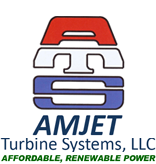TECHNICAL DETAILS
VARIABLE SPEED, the change that makes “Inside the Box”possible:
1)—HYDRODYNAMICS
The hydrodynamics of a given turbine can change flow rate in 2 ways:
a) Change rotational speed (the AMJET way) or
b) Change diameter of the turbine (Conventional way). Every varying application requires a different turbine diameter.
c) Every turbine needs the capability to change flow rate to adapt to actual dam requirements. The conventional way is by adjusting mechanical hydrodynamic surfaces to lower flow requirements to maintain constant speed but with loss of efficiency.
Changing ATS rotational speed does not require change in runner pitch/stator vane pitch. One Turbine diameter (=constant) fits many applications. Modular design makes the AMJET turbine/generator mass producible with power selection as a final assembly option.
The same basic hydrodynamics are applicable to a range of head and flow rate and always can deal with varying flow rates at NO LOSS of EFFICIENCY. Electronics maintain optimal efficiency at any head (rotary speed). Electronic inverter synchronizes automatically and instantly with grid.
ELIMINATES gear box, variable runner pitch, wicket gates, hydraulic controls, governor, synchronization switch gear and support and enclosure structure for these components.
2)—HIGHER OPERATING FREQUENCY (200-800Hz) requires up to 5X smaller electro-magnetics footprint and mass. Smaller electromagnetics allow Placement of generator around the runner in a common housing. It also enables a lighter, composite construction and additive manufacturing option of the complete turbine/generator structure.
ELIMINATES gear box, drive shaft, separate generator, volute housing cast into heavy foundation, support structure for these components, overhead crane and powerhouse.
REQUIRES electronic rectifier with torque control, inverter (to 480-680V 3Ph 50-60Hz output) with instant synchronization. (Cost is much lower, offset by vast hardware savings and maintenance costs)
3)—BENEFITS
a)—Instant electronic synchronization
b)—In-line flow-through design, for shorter time, more compact and efficient installation
c)—Simple support structure for servicing/replacing in one DAY
d)—Up to 5x lower weight and 5x smaller footprint
e)—Composite construction of structural turbine parts
f)—Reduced dam civil engineering and construction costs
g)—Shorter dam installation time
h)—Modular design enables volume production and power level selection at final assembly.
j)—Operates above or under water at any angle of operation
